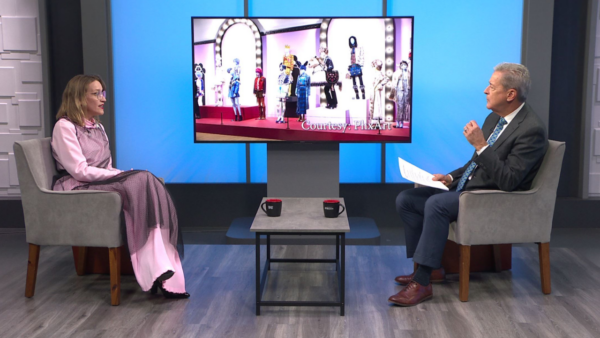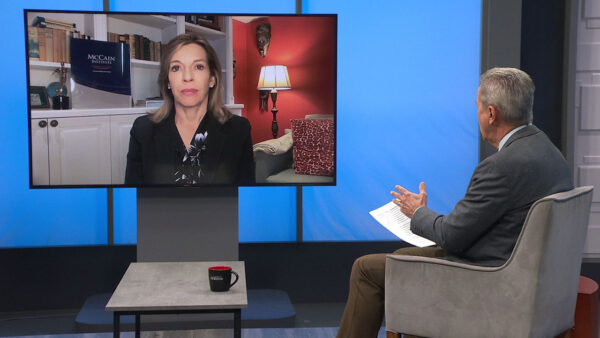Robert Melikian, whose family owns and operates the historic Hotel San Carlos in downtown Phoenix, is the author of “Vanishing Phoenix.” Melikian talks about historic preservation and shares photos and stories from his book of buildings and landmarks that have disappeared.
Ted Simons: To some people, the commercial development taking place in downtown Phoenix is a sign of progress. But to others, as David Majure reports, it's a reminder of vanishing Phoenix.
David Majure: At the corner of Central Avenue and Monroe in downtown Phoenix stands the hotel San Carlos.
Robert Melikian: It was Dwight herd's creation. He wanted an elegant hotel.
David Majure: Built in 1927, Robert Melikian has owned and operated the hotel. The kind of place where movie stars might stay.
Robert Melikian: This is where Mae west came and stayed. She chose it because it would charge a dollar more than any other hotel in Phoenix, Arizona, and had the gold SPIGOT in the bathroom and had air-cooled system here and also steam heat and the radiators and steam heat, we used the same system here, some 80 something years later.
David Majure: Inside, not much has changed in 80 years. Outside is another story.
Robert Melikian: It's been a growth, growth, growth attitude in Phoenix and that's a wonderful successful formula but it has a drawback. You ignore history and demolish your personal identity and lose out on the soul of downtown. We had magnificent buildings. Castle-like buildings and they had a lot of interesting buildings and for the most part they're gone.
David Majure: Torn down and replaced. The hotel San Carlos is among the few survivors.
Robert Melikian: It's the last operating historic hotel in downtown and one of a dozen hotel historic properties in Phoenix.
David Majure: Hoping to preserve them. Melikian authored "Vanishing Phoenix" --
Robert Melikian: I'm hoping the book will give people an interest in saving what we have left and the preservation ordinance, that's the key.
Ted Simons: Joining me to talk about "Vanishing Phoenix" is the book's author, Robert Melikian.
Robert Melikian: Thanks for having me.
Ted Simons: How much has vanished and why?
Robert Melikian: We have only have 20 in the core and in the last 25 years, a good 50 commercial buildings have been knocked down.
Ted Simons: Is it the idea that people were wanting go, go, go kind of thing?
Robert Melikian: It's a bottom line oriented business community we have here that is not -- they're from somewhere else. Strong individuals, don't want government to tell them what to do. And I can understand, I don't like it either, but they have no sense of preserving the past. And history is good for business.
Ted Simons: When we look at buildings, I hope we can talk about the craftsmanship and the detail on some of the older buildings. It's phenomenal. Was that something unique to Phoenix?
Robert Melikian: People took pride in their buildings and made them with quality and the labor was less expensive and could afford to put fanciful features that today it would be prohibitive to do it.
Ted Simons: You look at Phoenix and Tempe and Mesa, and older parts of town, there's an oasis feel. Even these buildings, zeroscaping is a big thing. Saving water and being environmentally conscious. But back in that day, you crossed a desert to get here and we're going to give you green. We are going to give you soothing atmospheres, correct?
Robert Melikian: It's a common feeling being in an historic building. Green, sustainable. It's the in thing to do. The most green thing to do is keep a historic building standing.
Ted Simons: The first is called the Clark Churchill house and this is a gorgeous -- where was this?
Robert Melikian: When I was researching my first book, I found an old box of photographs and it had this in it and thought this can't be Phoenix. This Victorian building. Fifth Avenue on the north side of Van Buren, Clark Churchill built this building and the panic -- came and there's a man on the left side of the image sitting on the roof and it was never finished. They can adapt to other uses and he sold the house and six city blocks for $15,000 to the city for the start of Phoenix Union High School and served the children for over 50 years until it was torn down in 1949.
Ted Simons: We showed what's there at that intersection right now and that looks to be Phoenix union high school, the biomedical campus, whatever you want to call it, but that's what it was, huh?
Robert Melikian: Thanks to Clark Churchill and the panic that forced him to sell.
Ted Simons: And the -- this building is the Anderson building. A beautiful structure.
Robert Melikian: This is First Street and Washington, the northwest corner. You can see the craftsmanship, there's the two towers there that a lot of craftsmanship took place and a draw for people. You can see the different eras of transportation there. The horse and buggy and bicycles and electrified trolley and two years after this was taken in 1900s, automobiles came to Phoenix.
Ted Simons: Why was this torn down?
Robert Melikian: It lasted until 1980s. It had lost its fanciful features and was boxed in but no one could assemble the block. It was an office -- the Barry Hill building. A furniture company, it was the use in this photograph. Doris Hayman Furniture Company.
Ted Simons: And still a busy corner in central Phoenix, but doesn't look the same, does it?
Robert Melikian: No, it doesn't have the pedestrian activity.
Ted Simons: The next is the Cotton Building, this one looks more familiar in the sense we have seen other territorial buildings looking like this.
Robert Melikian: It was in the southeast corner of Washington and Central. Banks accumulated a lot of money because of the commercial scale of agriculture that developed here once the railroad came and they were able to sell it and this one was one of the two founders of the city of Phoenix. John Y.T. Smith. He discovered -- he was the supply master for Fort McDowell and was able to become a bank director and discovered wild hay growing when the ancient Indian canals came, that's how we got the name of the Phoenix -- rises from the ashes of the old Indian canals.
Ted Simons: And this one, not as exotic. Why was the Cotton Building torn down?
Robert Melikian: The National Bank themselves thought it was old and tore it down within 15-20 years of this photograph. The bank grew so quickly, they wanted to maximize their lot there so they themselves tore it down.
Ted Simons: Let's keep it moving. The Fleming building, this one looks substantial. Maybe not as ornate.
Robert Melikian: James Fleming was a local businessman and he had a two-story building and was so successful that he added a third and fourth floor. And this lasted into the 1980s and could have been incorporated into the high rise development and made a distinctive development.
Ted Simons: They decided to tear it down? Why?
Robert Melikian: Because the owner had plans for a huge high rise and I understand that and I don't want the owners to subsidize history. I want the transferable development rights to give them the incentive to keep it standing and not to lose the ability to have a certain amount space.
Ted Simons: The next building I remember from back in the 1980s -- the Patton Opera House. Where was the Patton Opera House?
Robert Melikian: Fourth Avenue and Washington. It is 1,200-seat theater for vaudeville and live theater and community dances and this important building had a meeting took place where the landowners got together and decided to solve the unstable water supply and those landowners became Salt River Project and the Roosevelt Dam was decided in this building and this lasted until the 1980s until the city acquired it and knocked it down for the present City Hall.
Ted Simons: Yeah, because I knew I remembered -- well, I don't know if it looked that great there. But let's keep it moving. This is what we're seeing in that location right now, the present city hall. The Fox West Coast Theater and this looks like what you see in other cities. They're still standing, where they have these big beautiful theaters. The Fox isn't still standing.
Robert Melikian: S. Forest Lee was the architect and a famous theater designer and his inferior one in Los Angeles is considered the best in Los Angeles but he designed a better and more elaborate one for Phoenix and this is where a lot of Phoenix citizens had Saturday mornings of Saturday morning cartoons and on first and second street, Washington and Jefferson, took the whole block and a jewel of Phoenix history.
Ted Simons: And ornate inside. We have photos of the lobby. Look at that staircase, it's fantastic.
Robert Melikian: This is grand staircase. The streetlights were 15 feet high. And gold and silver leaf throughout the building and huge interiors and the next one here, the promenade outside of the doors of the theater, a huge area for people to mingle and interact and --
Ted Simons: That's great.
Robert Melikian: Look at the ceiling there.
Ted Simons: Yeah.
Robert Melikian: They don't make them like that.
Ted Simons: No, they don't. I want to go to our next. We have a couple of homes and these were actual residences and they look familiar because they're related to something that still stands. Dennis and Jacobs homes.
Robert Melikian: Along Millionaires Row on east Monroe from Central to -- the only one we have left is the Rosson house.
Ted Simons: And these look like the Rosson house.
Robert Melikian: The same period, the early 1890s. The one on the right, the Dennis one, lasted to the 1950s and the Jacobs to the 1960s and the theater was a valuable asset but it could have been put somewhere else. They could have been saved and made into museum and future generations could have learned what was important to people. The size of the rooms and layouts.
Ted Simons: This would be the Central School Building and this is where the Hotel San Carlos stands right now. This looks like something on Seventh Street. Reminds me of a building on Seventh Avenue. Was it the same architecture?
Robert Melikian: All the same. There's a well that still exists in the basement of the San Carlos. Dwight Herd acquired the lot and the building was -- the kids were living in the suburbs, Seventh Street and Seventh Avenue and the building was knocked down.
Ted Simons: We're looking at those things and now we're seeing a Renaissance in downtown Phoenix. What are your thoughts about that?
Robert Melikian: We have a chance to bring back soul and people interaction downtown but we have to require some street level activity. We have people building huge boxes of office spaces and nothing on the ground level. We lost the window of opportunity to build condominiums and people living downtown. People ask me all the time, what can we do downtown? The test of a successful downtown is people strolling. You want them to walk and interact. Bakeries and ice cream parlors -- bars. People want choices.
Ted Simons: They certainly walked back downtown in the old days around those gorgeous buildings. Your book is fascinating. "Vanishing Phoenix." Keep fighting the good fight.
Robert Melikian: Thank you very much, Ted.
Robert Melikian:author, "Vanishing Phoenix";























